
Biotope Blog 2024
December 17, 2024
Deep dive dilemma
Since we have created our pond in 2021, we have been trying to establish the native yellow water-lily (Nuphar lutea) – so far without success. The plants do not form floating leaves and die. Only one stout specimen manages to produce a single leaf each year.
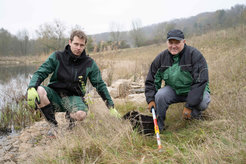
Why do we want water lilies? The colorful flowering water plants are not only a feast for the eyes, but they also provide a safe hiding place for tadpoles, for example, and are a habitat for insects such as dragonflies. They improve water quality by absorbing nutrients and producing oxygen. Their leaves provide shade and regulate the water temperature, stabilizing the pond ecosystem. Bottom line: lots of benefits!
But why is it not working with the water lilies? One possible reason: Our newly created pond is probably still low in nutrients. Nutrients should accumulate slowly so as not to endanger the sensitive ecosystem. However, water lilies need a lot of nutrients to thrive. That is why we planted them in a container with nutrient-rich substrate in our pond.
If it is not a lack of nutrients, the problem could be something else: that we have moved them into deep water too quickly. The chosen area in the pond is about 1.40 meters deep. The plant needs a lot of strength to reach the water surface.
Hence our new approach: We let the water lilies acclimate in shallow water until they are strong enough and have formed a few leaves. Then we lower them into deeper water with a rope. This year we are also trying to establish a new species of water lily (Nymphaea Gladstoniana) particularly suited to deep ponds.
Our gardener Benny Stark has bravely plunged into the water to implement the plan, risking wet feet. We hope that this attempt will be successful.
Diving water lilies
October 2, 2024
What’s the state of biodiversity in Germany?
The Faktencheck Artenvielfalt – a comprehensive report by more than 150 authors from science and practice on biodiversity in Germany – that was published at the end of September reveals alarming results: Valuable habitats are disappearing, 10,000 species are endangered, and more protected areas are urgently needed. Insects and open land habitats are particularly affected.
In addition to the intrinsic value of nature, the report – which is based on more than 6,000 publications – emphasizes the immense importance of ecosystems for our well-being and existence. Species-rich meadows, for example, store large amounts of CO2, while trees regulate the climate and filter rainwater.
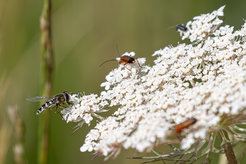
The diversity of plants and structures in turn increases the biodiversity of other organisms and makes the ecosystem more stable and efficient, the report says. Generally, the habitat quality is more important than the size of the protected area. Yet, monitoring is essential to ensure the effectiveness of conservation measures.
While the “fact check” paints a bleak picture in large parts, it also shows that our BioDiversum is a valuable part of the bigger picture. Our biotope should be a safe haven for endangered species. We maintain open land and provide food for many specialized species, such as wild bees on wildflower meadows – all under the most insect-friendly management possible, sometimes even undisturbed.
We have created a colorful mix of structures and native plants in our biotope, which has been shown to have a positive effect on a wide variety of species. Our regular monitoring is intended to ensure this in the long term.
Everyone should understand how essential biodiversity is. In our BioDiversum, you can experience nature, expand your knowledge, and learn to appreciate biodiversity. We can make a difference on a small scale and contribute to the big picture.

August 12, 2024
In a zigzag
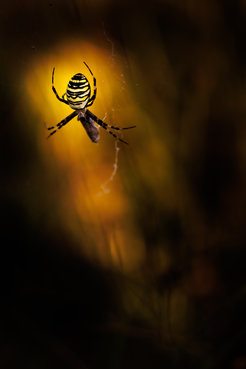
Large, colorful, striking – the wasp spider (Argiope bruennichi) is a real eye-catcher. The female, in particular, stands out from the half-high grass with a body length of up to 2,5 cm and white, yellow, and black horizontal stripes – much like a wasp. However, it is perfectly masked for predators such as birds and small mammals that prey on large spiders.
The native spider builds very special webs: It weaves a dense zigzag above and below the center of the web.
Why? There are many theories: It could stabilize the net, attract males as a “love path”, or camouflage the spider from predators and prey by sitting in the center on thin threads.
Favorite food? Clearly grasshoppers! In addition to jumping prey, it does not disdain other insects which are spun in and sucked out. Besides prey, the much smaller, inconspicuous male should also be cautious – it is eaten after mating.
Our BioDiversum offers the eight-legged inhabitant a perfect place to live: It makes itself comfortable in sunny, undisturbed, half-height grass.
August 1, 2024
Great memories
Best of: Kestrel Camera 2024
June 25, 2024
Off into the wide world

Yesterday morning, we watched the livestream of our now empty kestrel box with mixed feelings. Our beloved kestrels flew out faster than expected. After the first brave siblings left the safe nest on Thursday, June 20, the last straggler also made its first attempt to fly yesterday, four days later. It remains to be seen whether, how often, and when the young birds will return to the nesting box again until they finally leave their home during July.

For the young birds, learning to hunt is now first and foremost on the agenda. Slow, easier-to-catch prey – such as insects and earthworms – is gradually supplemented by larger animals, especially mice. During this learning period, the parents continue to feed them.
When the young kestrels are ready for an independent life in July, it is time to say goodbye. The family breaks up, and the offspring leave their birthplace. New territories of their own are usually no more than 75 kilometers away, but in single cases the young settle down over 300 kilometers from home.
It was a great experience to follow live as our pair of kestrels raised six chicks and how they became bright young birds! We are already looking forward to next year – when, hopefully, two kestrels will move into our nesting box again.
June 19, 2024
Grown up so fast
How time flies – only four weeks have passed since our six kestrel chicks hatched. In the meantime, our fluffy offspring have grown into impressive young birds with dense plumage. Fun fact: They do not get an adult plumage until they are two to three years old. Before that, all look very similar to their mother – whether female or male.
With six young birds, our kestrel box is well-filled. The chicks are in good health so far. That is not a matter of course and proves an excellent year for our kestrels. Now that the siblings can keep each other warm and sometimes eat independently, the hard-working parents have more time to gather food.
The young kestrels are already spreading their wings for testing purposes – not always to the delight of the siblings due to limited space. After dry runs in the save kestrel box, things get serious: The first flight attempts outdoors are on the agenda. These often end up in nearby trees or on the ground. We cannot wait to see the first young birds learning to fly and hunt over the Fassberg Campus!
Full house in the kestrel box
June 13, 2024
Netted
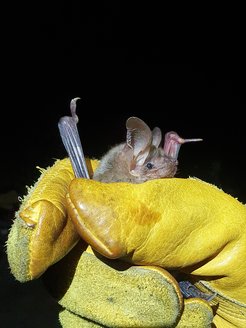
A nocturnal visit to the BioDiversum: At the end of May, two bat experts were lying in wait at our pond from sunset until the early morning hours. Why?
Commissioned by the city of Göttingen, they wanted to catch and tag bats to find out which species live in the Göttingen forest. Our biotope pond near the forest edge offered an ideal attraction for the thirsty and hunting mammals.
No sooner said than done: They set up large, fine nets and had gloves ready to carefully free and identify the captured bats.
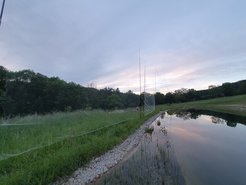
Four pipistrelle bats (Pipistrellus pipistrellus) and one greater mouse-eared bat (Myotis myotis) were caught in the net – but all were released without transmitters. The former species is not a forest but a building dweller, and the latter was a male, only females should be tagged. The experts could also observe a Daubenton’s bat (Myotis daubentonii) and a serotine bat (Eptesicus serotinus) above the pond. The sensitive animals quickly noticed the nets in the open landscape and stayed away from them.
We are happy about the exciting findings – with or without transmitters – and would like to thank David Singer and his colleague from the Office for Applied Animal Ecology!
May 21, 2024
Hustling and bustling in the kestrel box

After about four weeks of tense waiting, the time has finally come: Five of the six kestrel chicks have hatched over the weekend!
Hatching takes a lot of preparation and energy. The initially blind chicks begin to breathe a few days beforehand. As the shell becomes thinner and thinner and water evaporates, more air is available in the egg. It is also time to test the voice: The chicks communicate with their parents by making sounds to let them know whether they are doing well.
The real feat comes with the actual hatching. Vitally needed: the egg tooth, a sharp projection on the chicks’ beak – specially designed to break through the eggshell – which falls off after hatching. The little birds free themselves by pecking, pushing, squirming, and twisting.
We are curious to see when the last young one will free itself from the shell. Over the next few weeks, the female will keep the flimsy-covered chicks warm and cozy while the male is responsible for the feeding service. Lots to do for the new parents – take a look!
May 17, 2024
In honor of the wild bees
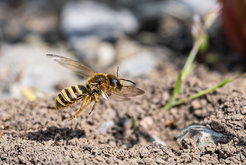
We cannot do without bees: With their busy pollination, the tiny insects perform indispensable work. Apart from the biodiversity on our planet, we owe them a large part of our food. What many people do not know: Wild bees – including bumblebees, solitary bees, and others – are essential for this food security. Many plant species can only be pollinated by certain wild bees, such as tomatoes.
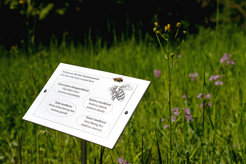
In our BioDiversum, we want to support wild bees because they do not have an easy life: food competition with honey bees, disappearing habitats due to sealed surfaces and missing deadwood, agricultural monocultures, and pesticides give them a hard time. Therefore, we provide open ground and deadwood for nesting, wildflowers for a strengthening meal, and a pesticide-free habitat.
According to our regular wild bee monitoring, the support has paid off since the project started: From 68 wild bee species in 2019, the species richness at our institute grew to 111 species by 2023 – an increase of 43 species! This result means that 30% of the wild bee species native to Lower Saxony live on our Fassberg Campus, including extremely rare representatives such as the wood-carving leafcutter bee (Megachile ligniseca).
May 20th is World Bee Day and a great occasion to draw attention to the importance of all wild bees. Our new bee signs – who is buzzing where – will hopefully make a small contribution. Here is to the wild bees!
April 22, 2024
The early bird catches the worm: Bird tour through the BioDiversum
Last Monday, on April 15 – before the day had even really begun – fifteen bird lovers from our institute gathered behind the canteen at the Fassberg. They wanted to explore the BioDiversum in a slightly different way: listening and with 10-fold magnification.

Equipped with binoculars and under the expert guidance of our hobby ornithologist Christian Dienemann from the Department of Molecular Biology, we set off on a bird tour through our biotope, unimpressed by the changeable weather. With lots of exciting stories and background information, two hours flew by.
A particular highlight was the large bird feeding station, a real bird magnet, where we could observe various species of tits, nuthatches, robins, and even the shy jay having breakfast. The endangered starlings were also real stars with their imitation skills: One of the blackbird-sized, shiny metallic birds skillfully imitated a red kite. We had to take a closer look several times to believe our ears.
A big thank you to Christian for this great tour! It will not be the last – to another morning with feathers and binoculars.
April 17, 2024
“Falcon Big Brother” – Our kestrel box gets a camera
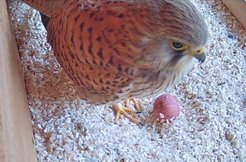
The kestrel (Falco tinnunculus) is among the absolute favorite inhabitants of the BioDiversum, at least for the biotope team. In the last three years, kestrel pairs have raised several young in the nesting box at tower 6 successfully twice.
But what does such a breeding process look like? Now you can find out: We have a new kestrel box with an integrated camera! The newly installed box – built by our in-house Carpentry and equipped with technology from the IT and Electronics Service – will now provide more detailed insights into the secret lives of our feathered friends via livestream.
The camera has already proved its worth in the test phase: We watched with great excitement as a pair of falcons moved into the nesting box. Two days ago, the first egg was laid! Now it is your turn to follow the life of our kestrel family – take a look!
March 21, 2024
Hatching underway
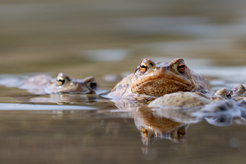
Numerous toads (Bufo bufo) are currently bustling around our pond in the BioDiversum. The reason: It is mating season!
Despite the demanding migration, it is time for the amphibians to hang on rather than rest. Several suitors surround the larger female, but only the strongest succeeds in clasping her tightly and mating with her. This also leads to confusion from time to time: In their hormonal frenzy, males sometimes clutch conspecifics of their own sex.
Vast quantities of egg strings – as long as two to five meters – already run like black pearls through our biotope pond. Over the next few days, the thousands of eggs – 3,000 to 8,000 per female – will hopefully hatch into many healthy tadpoles, which will be able to leave our pond as tiny toads in July. We are excited!
By the way, the common toad is a “specially protected” species under the Federal Nature Conservation Act. This means that it may not be caught, injured, or killed. To scare off predators, the toad produces a poisonous skin secretion. Even the dainty tadpoles have this poisonous protective shield. We keep our fingers crossed that this can shelter them from hungry mouths.
The Toad’s Tale
March 01, 2024
Oops, who is sleeping there?
But guess who we woke up: an indignant mouse! The wood mouse (Apodemus sp.) had made itself at home in one of our nesting boxes and was not happy when we disturbed its beauty sleep. Of course, we left it sleep in peace. Nevertheless, we could not let the cute video recording pass us by, so take a look – but shhhh...
By the way, mice normally do not hibernate. They go dormant at low temperatures to save energy but are otherwise active all year round. Wood mice are also only active at night. Therefore, they are particularly grateful for a warm, cozy place to nap during the day – like our nesting boxes.
February 12, 2024
More than just a box full of seeds
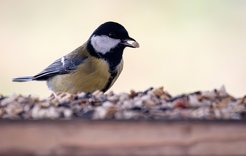
As the temperatures drop and the days get shorter, many of us think about how we can help wild birds through the cold season – with a bird feeder. We at the BioDiversum also provide our birds with valuable treats (not only in winter).
But a bird feeder in winter is more than just a food source: According to a new study from the Swedish University of Lund, winter feeding also positively affects birds’ health. With more reserves available, birds do not need to lower their body temperature as much at night to save energy, which is especially helpful in the case of feverish infections. The bottom line is that birds with access to feeders use less energy to fight an infection.
The study results encourage us to continue feeding the birds in the BioDiversum all year round. We believe it is an important contribution to the well-being of our little feathered friends in a changing environment.
Want to know how the Swedish researchers found all this out? Read the original publication here.
January 02, 2024
Playfully through the biotope

Our trainees have contributed two interactive information boards to the round tour of the BioDiversum. As part of the “Azubiprojekt” (apprentice project), they designed and built a quiz board and a board with a wildlife memory.
We are very happy about the new boards and would like to thank all trainees for their commitment!
















